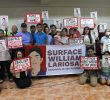My linguistic homecoming has made a remarkable impact on my growth as a celebrator of Lumad literature. It couldn’t be otherwise. The noble expression and stories of Mindanao’s Lumad peoples can only be written and told in the language most akin to their experiences and reality.
By DON J. PAGUSARA
Davao Today
Somebody asks, “Don, why are you so particularly sensitive to the question of language as medium of literary expression?”
The question strikes a delicate chord in my heart. It touches my very soul. And my answer, aside from being a lengthy passionate discourse, arises from my sentimental attachment to Cebuano, my mother tongue.
When I decided to make Cebuano the vehicle of my artistic expression, it was like returning to an ancestral home — to stay there for good. For quite a time I have been estranged from this home ground. Now, it has been a happy and comfortable life. In the literary sense, that is. It was a landmark decision, the best I have ever made for my artistic life.
I could have settled for English. For after all, it was where I was accustomed to shape my thoughts in all the years I was in school — some 40 goddamned years!
Oh yes, like all the rest of the schooled Filipinos, I had learned to love English. But thanks to my nationalist education, I have found my true love. Cebuano had always been there all the while, at some corner in the realm of my psyche, ever waiting like a faithful spouse for my return.
It could never be totally forgotten. Not, in spite of all the enticements of colonial education, notwithstanding that it was held in ridicule by most everyone in the academic community. For truly no other native language suffered humiliation more than my beloved Cebuano. The more it was transgressed, the greater my devotion to it.
My linguistic homecoming has made a remarkable impact on my growth as a celebrator of Lumad literature. It couldn’t be otherwise. The noble expression and stories of Mindanao’s Lumad peoples can only be written and told in the language most akin to their experiences and reality.
A “culture bearer” of any Lumad tribe in Mindanao has had some intimate inter-subjectivity with the Cebuano — both the people and the language. He often finds his bearing among the manifold cultural groupings by using the Cebuano language.
Indeed, it is the language of intertribal linkaging. The Subanen of Zamboanga relates with the Higaonon of Bukidnon not in any other tongue but Cebuano. The Blaan and the Manuvu, the T’boli and the Bagobo, the Mandaya and the Mamanwa have built their respective political networks via the conduit of a veritable lengua franca — decidedly, the Cebuano.
What could be a better medium for the collective expression of the Mindanao tribals than the language spoken by them in common. What could be more kindred in form and spirit to their intimate feelings and thoughts than the vessel from which they have derived common vocabulary. And what greater reason then that I should render artistic expression of the Lumad soul in Cebuano.
There is much deeper kinship experienced by the Lumad languages with Cebuano than with any other language in the region. And it is in the particular uniqueness of this kinship that their artistic expressions find aesthetic shapes and dimensions.
How else, for example can the tribal warrior, the Bagani — verbalize the nobility and valor of his race than in terms very familiar and natural to his existential reality? Only the sinewy texture of the Cebuano language can truly deliver the force of his tribal reason, the strength of his racial conviction.
In my ethnic rock opera Sinalimba, the symbolization of Bagani’s virtues as a Lumad culture hero cannot but be lyricized like no other language can do, thusly:
Bagani Bagani [Bagani Bagani
Alimpulos sa hangin Tempestuous winds
Bul-og sa dulog Surging headwaters
Buhawi sa kakusog Strong as tornado
Kalayo sa kaisog Fire in his valor]
In another play, Bungkatol ha Bulawan, the same euphonic tenacity could be discerned in the song of the baylan:
Sangpiton ko sangpiton [I shall call, yes I shall call
Tawgon ko pagtawgon I shall invoke the almighty
Si Magbavaya , O Magbavaya Magbavaya O Magbavaya
Tultoli akong dila Guide the flow of my tongue
Himoang sapa akong dila Transform my tongue into a river
Kining saysay sa kasinatian In this narrative of our history
Agosan unta sa kamatuoran May pure truth flow]
And this universal oneness with nature, woven in the characteristic flowing lilt of native poetry, borrows its life-pulse from the Cebuano tongue’s own vitality:
Dalisayng hangin nag-agos [Fresh winds blowing
Nanuhotsuhot sa mga suok Into all nooks and corners
Gihapyod mga gihay sa bulak Caressing the petals of flowers
Ug mga dahon sa kalasangan And leaves of forest trees —
Dayandayan lang ba kini Are these mere décor
O lintunganay sa kinabuhi? Or essences of life?]
The basic truths about Mindanao’s tribal communities, their separate pains, their pulsating wounds, their strife and quests for justice and freedom are sacred parchments lodged in the hearts of the Lumad peoples themselves. These form part of their lores and poetry which only they can fully reveal and recite. But these are separate only in so far as there is a common vocabulary that has hitherto stitched them into a common history, a common struggle and a common dream.
But Mindanao’s truths also pulsate somewhere else — in all other places in the island, in the shadowed contours of the rugged social terrain, in the darkened narrow alleys of urban enclaves, in the entrails of the cities. Certainly, in Davao City’s Agdao, and elsewhere — in every other city’s and town’s urban poor communities — there, the Cebuano lyricist can meet with the common man’s dream: the Visayan settler’s, the Boholano migrant’s, the Leyteno farmer’s — who have made Mindanao an irony of a promised land.
Kami ang mga damgong dagsa [We are the stranded dreams
Sulod sa utlanan sa siyudad in the borders of the city
Bato balani ang iyang kaanyag Magnet is her charms
nga kanamo mibihag. that captivated us.]
Nagdasok sa among dughan [Dumped into our breasts
ang libulibong tinguha are a thousand and one wishes
Apan kapakyas ang nagsiaw But failures have teased us
sa among mga adlaw in our daily lives
Among barungbarong panagsa Our shanties are seldom
da hagki sa kahayag kissed by sunlight
Inigsanap sa dagkong baha When big flashfloods come
among damgo mabanlas. our dreams are swept away.]
Here, the Cebuano artist derives a rich sustenance of his art. In his intimate association with the community people, he taps a vein of literary resource. Such is home enough. Wherever his literary impulses direct the outbursts of his songs and poetry, there is communion with the people with whom he has developed close cultural affinity.
Mindanao is characteristically Cebuano. Nobody dreams truly Mindanaon and not dream in Cebuano. That is so because the language that can provide bridges among the entire people is the language that throbs with the heart of the teeming poor, the deprived, the oppressed.
I recall a cultural night shared with the community folks where I live. Around the bonfire we gathered on the beach, close to where my nipa cottage breathed with the rhythmic lapping of the sea waves. An elderly fisherman beside me coughed and with it a question hung in the night air, “Why of all places, Don, have you chosen to live with wretched people like us in a wretched place like this, ha?”
Why? The query echoed in my throat and stayed there a few seconds before I could articulate in the best of Cebuano what I have long tucked in my breast: This is where I have found my home. This is where I am at home with my own language and culture, where I am with my own people.
Don J. Pagusara is a native of Mindanao, a multi-awarded author and a Palanca-awardee.
language, Mindanao









